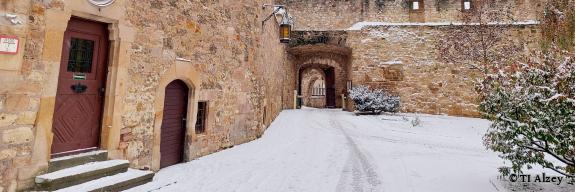
City walk for everyone in Alzey

The city walk takes you through the centre of Alzey and past 12 places of interest. These include the Rossmarkt and the fish market. 8 stops are accessible for wheelchair users without restrictions. There is a description board with a QR code at each point of interest. This leads to voice output of the text.
Places of interest
1 Museum Alzey/Tourist Information
Today's Museum of the City of Alzey was built in the 16th century as a hospital building. The stair tower at the side and the window jambs are still recognisable from the time of construction.
window jambs. After being destroyed in the Palatinate War of Succession in 1689, the hospital was rebuilt in 1747/48 in the Baroque style with a spacious mansard roof.
The museum is open all year round.
Mon - Fri 10.00 - 12.30 and 13.30 - 16.30
Sat, Sun, public holidays 10.00 -12.00 and 14.00 -16.30.
Free admission!
2 Town wall, pigeon tower and Georg Scheu monument
Integrated into one of the restored sections of the old town wall is the pigeon tower, which has also been restored.
In front of the town wall stands the monument to the
important Alzey vine grower Georg Scheu
(1879-1949). Scheu's cross-breeding programmes
the well-known grape varieties Scheurebe,
Huxel-, Faber- and Siegerrebe as well as Kanzler,
Würzer, Regner and Septimer.

3 Small church (built in 1728/1729)
The simple, baroque hall building with its surrounding galleries and the pulpit dominating the front of the room corresponds entirely to the principles of a Protestant church building in its sober purposefulness.
principles of a Protestant church building.
One of the special features of the church is an organ built in 1737 by the famous Hunsrück organ builder family Stumm.

4 Municipal winery
The estate was built around 1850 in the style of late classicism. Following the example of aristocratic palaces, the building complex is grouped around a courtyard of honour enclosed from the street by a fence. The estate, which was bequeathed to the town in 1916, is now run as a winery for the town of Alzey.
Tip: Art exhibitions are regularly held in the Burggrafiat opposite.

5 Alzey Castle
The castle, which was probably built in the 13th century, was the nucleus of the Rhenish Palatinate, a secondary residence and the seat of the local administration.
In the 15th and 16th centuries, the castle was expanded into a prestigious palace complex, which was heavily destroyed during the Palatinate War of Succession.
In the wake of the Romanesque-inspired castle restoration wave of the 19th century, the ruins were rebuilt at the beginning of the 20th century.
Today, the castle houses the local court and boarding school.

6 Roman fort
In the 1st century AD, a Celtic predecessor settlement developed into a Roman vicus, a small town centre with trade and commerce, a spa with healing springs and an associated cult district. The Alamanni destroyed the town in 352.
A fort was built on part of the site between 368 and 370. The mighty defence structure only lasted a few decades. Roman rule on the Rhine came to an end in the middle of the 5th century. This was followed by the time of the Franks, beginning with the reign of the Merovingians.

7 Obermarkt with St Nicholas' Church
The large open space of the Obermarkt, which became the town's marketplace in the 19th century (livestock and fruit markets were held here, as well as annual markets and the winegrowers' festival), was part of a Franconian court in the Middle Ages, later the Palatinate court.
Palatinate court.
The square is bordered to the south by the late medieval
It was built in several phases over the course of the 15th century and completed in 1499 with the completion of the church tower.

8 Witches' Bleachery
Hexenbleiche is a romantic corner with remnants of the medieval town wall and the oldest remaining tower of the town fortifications, the Metzgerturm.
It is popularly known as the "witches' tower", which the Mainz artist
artist Karlheinz Oswald refers to with his bronze sculpture "The Little Witch".

9 Atzel
Atzel Street is a narrow street with typical 18th and 19th century petty bourgeois old town buildings. House Atzel 3 dates back to the 17th century and is one of the few houses from the period before the Palatinate War of Succession.

10 Spießgasse
The street still has a large number of houses of architectural and artistic value, particularly from the 18th and 19th centuries. The oldest house in the street is a 1570
plastered building erected in 1570, which was given a curved Baroque gable in 1669.
11 Fish market with "old town hall"
Until the end of the 18th century, fresh fish from the Rhine was also sold on this square. The square is dominated by the
town hall with its striking polygonal stair tower.
Today, this houses a carillon with a figure of the minstrel Volker von Alzey (playing times: 10 am, 12.05 pm, 2 pm, 4 pm, 6 pm, 8 pm).
The Renaissance building itself was erected in 1586 using stones from the demolished Weidas monastery.

12 Rossmarkt
The name of the square goes back to a horse market held here in earlier times. The square is characterised by the Rossmarktbrunnen fountain (designed by Neustadt artist Gernot Rumpf) and the two gabled half-timbered houses from the 17th century facing the square.
the square are the two decorative half-timbered houses from the 17th and early 18th centuries.


